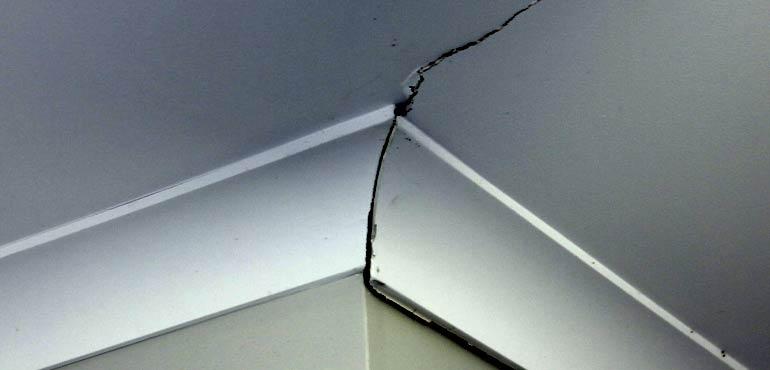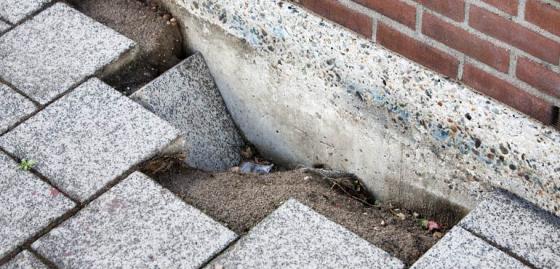
- Home
- Your property
- Maintain and protect
- Protect against subsidence
Protect against subsidence
Soil type, location and the water content of soils can cause building foundations to move. This is known as subsidence or heaving.
If one part of the ground beneath a building moves more than another part, the building may crack.
Subsidence causes
Most Queensland homes are built on clay soils. Dry seasons cause these soils to dry out rapidly. Wet seasons cause these soils to become wet quickly. This can cause sudden extreme volume changes and soil movement. Sandy sites and rocky terrain are usually not prone to this expansion and contraction.
Subsidence can be caused when the:
- soil compresses under the weight of the house
- soil swells and contracts because of changes in the moisture content.
How to prevent subsidence
Your house should be able to withstand soil movement from normal seasonal changes, if you:
- make sure your home's footings are designed and built correctly
- maintain your house and garden to avoid changes to the soil water content.
Design footings correctly
Before building or extending a home get advice from a qualified Registered Professional Engineer about which footing system to use. Either you or your builder can engage the engineer.
In Queensland, engineers design footings to the Australian Standard AS2870 – 2011 Residential slabs and footings.
To design and build a footing that reduces the chance of subsidence you must:
- classify the site
- select the correct footing system
- design the structure appropriately
- build in accordance with the required design details and methods
- maintain the building.
Maintain drainage
Keep the site well drained by avoiding:
- altering the site drainage
- placing gardens, garden edging or gravel pavements next to your house.
If you need to alter the site drainage make sure you direct water away from your house and adjoining properties.
Maintain your home to make sure your footings aren't damaged by water leaking from:
- roofs
- gutters
- hot water systems
- air conditioning units
- water tanks.
Consider impact of landscaping and gardening
Landscaping can make a huge difference to how your home looks and how cool it is. However, it's important to consider site drainage and surface levels when planning and maintaining your garden.
A well landscaped garden will direct rainwater away from the building, ensuring water does not pool near the footings. If you are planning a new garden, check the building plans or speak with a building professional to ensure landscaping or garden plans won't affect site drainage or risk structural damage to your home.
Keep your garden well drained to stop water pooling around your footings:
- Plant trees that need a lot of water well away from your home.
- Keep garden, garden edging or gravel pavements away from your house.
- Locate ponds and water features away from the building.
- Don't over-water the garden.
- Avoid unregulated sprinkler systems.
- Avoid installing a sprinkler system next to your house if it is on an extremely reactive site.
- Ensure that brick weep holes do not end up below soil level.
When thinking about removing or planting trees consider the possible effects on your footings:
- Cutting down a well-established tree next to your home could create a subsidence problem.
- Planting a tree next to the building can take up a lot of ground water and cause subsidence when fully grown.
Acceptable movement
Some damage to homes is expected from movement caused by subsidence. Some cracks are considered to be normal and repairing them is a routine part of home maintenance, while others should be investigated to determine what is causing the problem.
Certain problems are deemed acceptable under the Standard:
Acceptable
- walls with hairline cracks
- walls with cracks that are noticeable but easily filled and are less than 5mm wide
- doors and windows that stick slightly
- concrete floors with hairline cracks less than 2mm wide
- concrete floors with distinct cracks where the slab has a noticeable level change (test it by measuring the deviation from a 3m straight edge centred over the defect — it is acceptable if it's less than 15mm)
- a change in slope from horizontal or vertical less than 1 metre over a distance of 100 metres.
Not acceptable
- cracks over 5mm wide that mean all or part of the wall will need to be replaced
- noticeably bulging walls
- doors or windows that stick and distort
- concrete floors with cracks wider than 2mm
- concrete floors with distinct cracks where the slab has a noticeable level change (test it by measuring the deviation from a 3m straight edge centred over the defect — it is not acceptable if it's greater than 15mm)
- a change in slope from horizontal or vertical of more than 1 metre over a distance of 100 metres.
If you discover a subsidence problem
If your house has any of the issues that are not acceptable under the Standard it is possible you have a subsidence problem.
Contact your builder
If you notice subsidence, tell your builder. They are responsible for fixing any issues caused by their building work within 6 years and 6 months of them commencing the work.
If your builder does not agree to fix the problem, you can lodge a complaint with us. We will assess your complaint and determine if we can help you resolve the matter or if you are eligible for a claim under the Queensland Home Warranty Scheme.
Site inspection
After you lodge a subsidence complaint with us we will send an inspector to assess the site.
The contractor responsible for building the home will be invited to attend the inspection with the home owner.
The inspector will:
- check if the contractor has complied with the Building Code of Australia by creating the required movement joints in:
- masonry
- internal finishes
- storm water
- sanitary
- site drainage
- note any changes made after construction that may be contributing to the movement
- check maintenance issues such as:
- leaking taps
- air conditioning lines discharging next to footings
- blocked gutters and downpipes
- record the effects of the movement, including:
- cracking
- sticking windows and doors
- any visible cracked pipe work
- take a set of floor levels and record them on a floor plan of the building for later assessment.
Possible outcomes
The QBCC inspector will determine:
- if the contractor needs to rectify any defective work
- if the owner needs to do any maintenance or repairs
- if the owner needs to have the plumbing tested to check for leaking or broken pipe work
- if the building is performing within the expectations of the Standard.
If the movement is more than the Standard allows and is not caused by defective work or a lack of maintenance, the QBCC may engage an engineer to investigate further and propose a solution.
